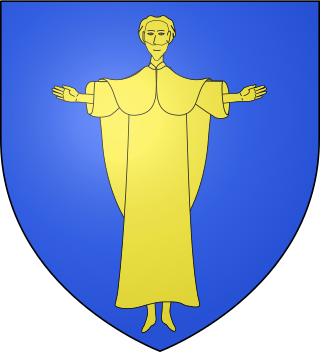Related Research Articles
Pope Celestine I was the bishop of Rome from 10 September 422 to his death on 1 August 432. Celestine's tenure was largely spent combatting various ideologies deemed heretical. He supported the mission of the Gallic bishops that sent Germanus of Auxerre in 429, to Britain to address Pelagianism, and later commissioned Palladius as bishop to the Scots of Ireland and northern Britain. In 430, he held a synod in Rome which condemned the apparent views of Nestorius.

Saint Quadratus of Athens was a Greek Apostolic Father, bishop of Athens. He is counted among the Seventy Apostles in the tradition of the Eastern Churches.

Phocas, sometimes called Phocas the Gardener, is venerated as a martyr and saint by the Catholic and Eastern Orthodox Churches. His life and legend may have been a fusion of three men with the same name: a Phocas of Antioch, a Phocas the Gardener and Phocas, Bishop of Sinope.

John Dawson Gilmary Shea was a writer, editor, and historian of American history in general and American Roman Catholic history specifically. He was also a leading authority on aboriginal native Americans in the United States. He is regarded as the "Father of American Catholic History".

Ludger was a missionary among the Frisians and Saxons, founder of Werden Abbey and the first Bishop of Münster in Westphalia. He has been called the "Apostle of Saxony".

Feb. 2 - Eastern Orthodox liturgical calendar - Feb. 4

The deacon Apollonius and his convert Philemon were Christian martyrs of the Diocletianic Persecution around 303. Philemon was a famous flute player, mime and actor at Antinoöpolis in Egypt.

Romanus of Caesarea, also known as Romanus of Antioch, is venerated as a martyr. A deacon of Caesarea, he was martyred at Antioch.

Julian and Basilissa were husband and wife, and are venerated as saints in the Roman Catholic Church and the Eastern Orthodox Church. They were Christian martyrs who died at either Antioch or, more probably, at Antinoe, in the reign of Diocletian, early in the fourth century, on 6 January, according to the Roman Martyrology, or 8 January, according to the Greek Menaea.

Richard Phelan, D.D. was an Irish-born prelate of the Roman Catholic Church who served as the fourth bishop of the Diocese of Pittsburgh in Pennsylvania, in the United States from 1889 to 1904.
Barbatus of Benevento, also known as Barbas, was a bishop of Benevento from 663 to 682. He succeeded Ildebrand in this capacity. He assisted in a church council called by Pope Agatho in Rome in 680 and in 681 attended the Third Council of Constantinople against the Monothelites.

Andeolus or Andéol is an alleged Christian missionary martyred in Gaul.

Benjamin was a deacon martyred circa 424 in Persia. Benjamin was executed during a period of persecution of Christians that lasted forty years and through the reign of two Persian kings: Isdegerd I, who died in 421, and his son and successor, Varanes V. King Varanes carried on the persecution with such great fury that Christians were submitted to the most cruel tortures.
Firmilian was the Roman governor of the Iudaea Province, during the third Late Roman Period of the Roman rule over the region. He was the third of a succession of governors who enforced the Diocletian Persecution at Caesarea, the province's capital, which lasted for twelve years. He is commonly referred as cruel and sadistic for torturing and killing many Christians and being heartless even to his close allies. He was beheaded for his crimes around 310 AD, by the emperor Maximinus’s order, as his predecessor Urbanus had been two years before.

Serapia was a Roman saint, a slave and martyr, also called Seraphia or Seraphima of Syria.
Saint Pinytus, a Greek by birth, was Bishop of Knossos in Crete in the late 2nd century.
Philogonius was a lawyer and an early Bishop of Antioch who came to be considered a saint. He opposed Arianism when that heresy emerged in Alexandria, Egypt. His feast day is 20 December.
Saints Meuris and Thea were two Christian women who were martyred at Gaza, Palestine. Their feast day is 19 December.

Saint Nemesion was an Egyptian martyr in Alexandria, Egypt during the persecutions of Christians by the Roman emperor Decius. A group of other Christians were martyred at the same time. His feast day is 19 December, or 10 September in some calendars.
Saint Gordius was a Christian soldier in Cappadocia who was dismissed from the army, lived as a hermit for a while, then returned and made an open declaration of his faith, for which he was martyred. His feast day is 3 January.
References
- 1 2 Butler, Alban. Lives of the Saints, Benziger Brothers, 1894
- 1 2 Shea, John Dawson Gilmary. “Saints Adrian and Eubulus, Martyrs”. Pictorial Lives of the Saints, 1889. CatholicSaints.Info. 1 February 2014
 This article incorporates text from this source, which is in the public domain .
This article incorporates text from this source, which is in the public domain . - ↑ Monks of Ramsgate. “Hadrian and Eubulus”. Book of Saints, 1921. CatholicSaints.Info. 1 September 2013
 This article incorporates text from this source, which is in the public domain .
This article incorporates text from this source, which is in the public domain .